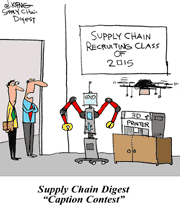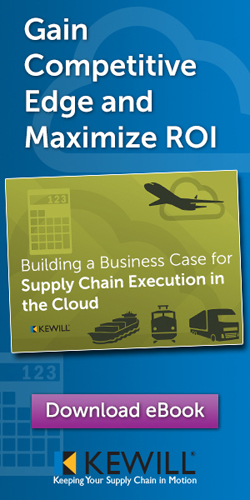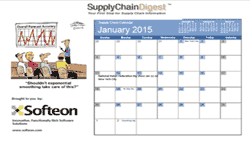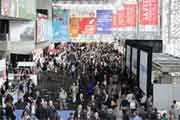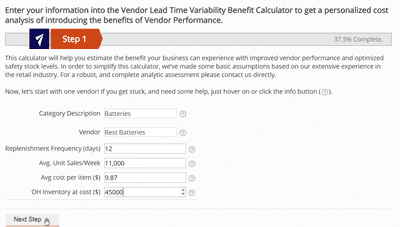 |
January 16, 2015 - Supply Chain Flagship Newsletter |
 |
| FEATURED SPONSOR: KEWILL |
||
 |
||
|
||
 |
|
||||||||||||||||||||||||||||||||||||||||||||||||||||||||||||||||||||||||||||||||||||||
Many of you have viewed my Day 1 and Day 2 video summaries. Written trip report here today. From a big picture perspective the dominant themes for the third straight year were Cloud, mobile, omnichannel and "advanced analytics." Virtually 100% of new software solutions are Cloud-based and embrace mobile. This is simply where the train is headed. Development on these new age platforms is simply substantially easier and faster than on more traditional technologies, among other reasons for the migration. With regard to omnichannel and analytic solutions, there are certainly no lack of potential vendors - there were dozens of each on the show floor. For omnichannel, a couple of demos from solution providers convinced me just how challenging it is to effectively plan and execute across a complex channel environment - which for global companies adds the variable of "country" into the channel mix. And as I have long said, omnichannel is simply mostly a technology driven problem - your systems can either support one pool of inventory across channels or they can't. If they can't, then you must unfortunately maintain separate inventories by channel, as just one example.
I am still struggling a bit understand what makes "advanced" analytics different than we had before, and how analytics based planning solutions differ from more traditional ones. Some folks at an analytics-based vendor called Manthan helped me a bit further down the knowledge path, which I will summarize like this: advanced analytics differ in large part from traditional analytics in being more predictive and prescriptive, versus providing insight to what has already occurred. Advanced analytics solutions differ from more traditional approaches basically in how the math works. Manthan claims analytics can include more variables in producing an answer than heuristic and optimization-based tools, and that (at least in Manthan's case) the tools are capable of "machine learning" that will improve results over time. I am sure more traditional planning vendors have a different view - more on all this soon in SCDigest, I promise. For some reason, the analytics-based solutions for forecasting, inventory, replenishment, etc., all seem to be retail focused, and I am not sure why. I got mixed feedback on where item-level RFID is at in retail. A few vendors painted a very bullish picture. On the other hand, Intel's Scott Thomas has concerns it's just taking too long to gain traction beyond the relative handful of the same names we keep hearing (Macy's, American Apparel, Walmart, Zara, Kohl's, a couple of others). Thomas thinks it's because it's just too hard and expensive to get things set up inside a store. Intel was demonstrating a simpler system that could easily tie together readers across a store. Intel is not pushing RFID systems, but rather trying to goose the market so it sells more servers and analytics to leverage all the data. I will note, however, that the Impinj booth seemed to be quite busy with retailers interested in at least looking at its xArray system, which provides what I call "wide area" reading capabilities. A pizza box sized reader with various antennas is mounted on the ceiling, and can provide continuous reading of products/tags, versus the more intermittent data updates achieved when using portal readers at the entrance from the back room and handheld readers for occasional physical inventories. One xArray can cover some 1500 square feet, with multiple systems deployed to cover the floor space of any particular store.
Some, including both Impinj and Tagsys, see this wide area approach as having applicability for distribution centers as well as stores, but after my discussions I am not optimistic about this happening for a good number of years. The read distances and coverage areas are just too small, and would require a ton of hardware to cover even a medium sized DC. We'll see. In better news, apparently you can now very reliably move a pallet through a portal reader and identify every carton that's on it. That wasn't true not long ago. However, reading tags inside a carton on a high speed conveyor is still quite a challenge - what tag is in which carton? Impinj exec Larry Arnstein says too many companies/vendors try to solve the problem through "physics" - turning up read signals, shielding areas on the conveyor, etc. Arnstein sees the solution as coming from smarter analysis of the data coming in from the readers - you can kind of triangulate to determine which tags are in which box. A couple of just general notes on large, well-known companies: Both Manhattan Associates and Oracle each made acquisitions of POS companies in the last six months ago, mobile POS-based provider Globe Bay in Manhattan's case, and Oracle of the more well-known Micros. The Manhattan move continues that company's move to offering a comprehensive retail solution from its supply chain roots, while with Micros Oracle gets a specialized retail distributed order management solution in addition to the POS capability. Interesting how this is playing out. Perhaps no supply chain-related company has transformed itself more over the past year than Zebra Technologies, after its acquisition of the wireless systems and bar code scanning business of Motorola. This is taking what was almost exclusively a bar code printer and label company into more of a systems provider, albeit one that relies mostly on a reseller network. The Motorola brand name, by the way, is simply gone - something that surprises me. It's not being run as a separate business unit, which also surprises me. However, Zebra is apparently bringing back the old Symbol Technologies brand (which Motorola had acquired) for some scanning products. That's interesting too. Also interesting is that Zebra has now launched its own Voice solution in the US. Motorola had relied solely on Voice partners in the US (e.g., Voxware, Lucas). It did have its own Voice solution in Europe through its Psion unit, and that is what has now been brought to the US market. This perhaps opens up opportunity for its resellers that sell Voice from Vocollect, but won't make its existing Voice partners happy. New JDA CEO Bal Dail delivered the NRF keynote presentation Sunday afternoon. I wasn't in town yet, but caught up with him on Tuesday. He said his main theme was that "Bricks are the new black," meaning that even in a multi-channel world, physical stores are essential to retail profitability, but only if stores are re-energize both in terms of consumer experience and omnichannel capabilities, such as "intelligent fulfillment." I had hoped to have room to describe some of the interesting solutions, but I don't. You can see those brief product reviews in the Day 1 and Day 2 videos, and as usual we will break each out into a separate video clip next week. New York City was packed with visitors, by the way.
|
|||||||||||||||||||||||||||||||||||||||||||||||||||||||||||||||||||||||||||||||||||||||
|
|||||||||||||||||||||||||||||||||||||||||||||||||||||||||||||||||||||||||||||||||||||||
|
|||||||||||||||||||||||||||||||||||||||||||||||||||||||||||||||||||||||||||||||||||||||
|
|
|
YOUR FEEDBACK
We received a large numbers of emails regarding our First Thoughts piece on What Would You Tell Accountants about Supply Chain? Parts 1 and 2.
There were such a number of good ones, we are not going to select a Feedback of the Week, but will rather just publish a few of the better ones thins week and next.
Feedback on What Would You Tell Accountants about Supply Chain?:
Your speech to accountants admirable but maybe can be even more specific? When you study accounting there are three branches:
1. SEC, GAAP, etc. 2. Tax accounting - we all know what that is 3. Cost accounting Any good accountant knows cost accounting - either love it or ignore it as not the way the make money Aligning a cost accounting system around the cash flow, inventory flows, outside commitment flows (e.g. purchasing, contract manufacturing) is a secret weapon for better business management Accountants have been trying to do for years but lack a model to follow. If they would take a lead from a supply chain model to capture cost accounting everyone wins I think that is all you have to propose then prove a few facts I think we know: 3. supply chain measurement of inventory flows a great "audit" tool to know what is going on
positions. create competitive advantage, etc. - the list goes on.
So then accountants can have facts to know how understanding supply chain can help their clients or help their practice. At least they can say to clients... managing your business using traditional accounting only measurement is not "optimal" ? The fight goes on but at some point formal business measurement systems will be based on an S&OP based supply chain model... just makes to much sense. In the meantime we will continue to play translator. :) Jon Kirkegaard
|
||
| This is excellent. A couple of points for feedback: First, the article you are looking for is: Second, a few points you may want to consider: Taxes. The Global Supply Network is a critical determinant of the global tax bill that companies pay, in terms of location, value-add operations, facilities, employment, inventory stocking (inventory taxes), etc. Equally important, the "traditional" notions of inventory as a bad thing are moving fast towards inventory being a competitive weapon, particularly as the cost of capital is so low. I would also add (but this may be a little less relevant) the fact that the adhering to global trade requirements (and penalties) are important in the core operations of the supply chain. Finally, we should note that the supply chain is a cash engine (which you mentioned) and a critical driver of customer growth (read "sales" and "margin"). Christopher Gopal, PhD Drucker School of Management
|
SUPPLY CHAIN TRIVIA ANSWER
Q: What percent of total US employment is in manufacturing (blue and white collar workers in factories)?
A: 4.86% at the end of 2013. It may have crept up just a bit in 2014.
| © SupplyChainDigest™ 2003-2015. All Rights Reserved. SupplyChainDigest PO Box 714 Springboro, Ohio 45066 |
POWERED BY: XDIMENSION
|
